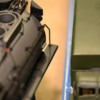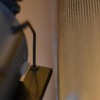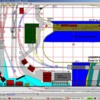So there I was looking at the layout plan, and wondering if my larger locomotives and freight cars would really be able to safely pass one another on the curves with the proposed four and one half inch center to center spacing. Another issue was would the three inch spacing from walls to the center rail work on the outer curves. It was time to use my test loops: three concentric loops of Atlas track. The loops, progressing inward, had O-72, O-63 and O-54 curves on each corner. On one corner, the O-72 and O-63 had been replaced with O-81 and O-72 respectively. On a second corner the outer curves had been changed to O-99 and O-90. Spacing between center rails was four and one half inches.
For the first test, the Lionel UP Vision Challenger slowly pulled my standard test consist (which includes an Atlas Articulated Auto Carrier, a MTH Schnabel car, a postwar Lionel 6418 machinery car and Vision tank cars on the outer loop past the Lionel Vision Clinchfield Challenger halted midway through the O-72 curve. While the Challengers passed one another with reasonable clearance, the forward portion of the Clinchfield Challenger walkway came within a quarter of an inch or so of the side of the auto carrier and almost as close to the Schnabel load. The clearance was also close, but passable, for the ladders on the Vision tank cars.
The next test had a Lionel Legacy Big Boy on the O-72 curve. The Challenger slipped by, but there was an interference fit (negative clearance) with the auto carrier.
I next parked the Big Boy on the O-90 curve and tried to run the test by on the O-99 curve, with the same results. The Schnabel was also confirmed as a no go.
A bit concerned, I replaced the O-99 and O-90 curves with O-108 and O-99 respectively and re ran the test; no problems!
The final passing test had the Big Boy on the O-72 curve and a Lionel DD35A (alone) on the O-81 curve; again, no issues!
To check the wall clearance, I placed a cardboard box three inches from the center rail coming out of the O-81 curve and ran all of the locomotives through the curve; close but no issues were observed.
I hope that this is helpful for some of you. It is nice to know that if my layout ever gets completed, trains will not be banging into one another or the walls (if the track is laid according to the plan).
First two photos are auto carrier passing Challenger during first test. Next is Challenger passing Challenger. Finally, tank car passing Big Boy.

















